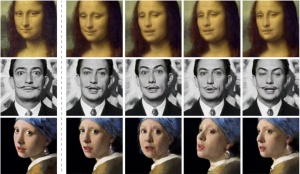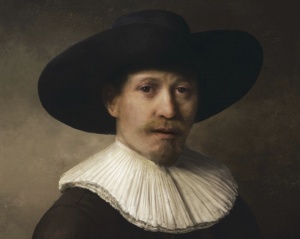Difference between revisions of "Generative Media"
| Line 1: | Line 1: | ||
| − | '''Generative Media''' is a process of algorithmically and autonomously generating forms of media, such as art, photographs, music, literature, and any other means of communicating in a creative way. It is media constructed with complex systems of mathematical formulas | + | '''Generative Media''' is a process of algorithmically and autonomously generating forms of media, such as art, photographs, music, literature, and any other means of communicating in a creative way. It is media constructed with complex systems of mathematical formulas, which mimic human ingenuity. Generative media goes by many names such as "synthetic media" or "organic media" because it is content created without human intervention. The creation of creative material usually takes a significant amount of time, which generative media streamlines... drastically cutting the creation process time down. The term “synthetic media,” refers to all automatically and artificially generated or manipulated media, such as synthesized audio, virtual reality, and even advanced digital-image creation, which today is highly believable and “true to life.” [https://en.wikipedia.org/wiki/Deepfake Deepfakes], a subset of generative media, is of the most concern today.<ref> L. Whittaker, T. C. Kietzmann, J. Kietzmann and A. Dabirian, "“All Around Me Are Synthetic Faces”: The Mad World of AI-Generated Media," in IT Professional, vol. 22, no. 5, pp. 90-99, 1 Sept.-Oct. 2020, doi: 10.1109/MITP.2020.2985492.</ref> |
[https://en.wikipedia.org/wiki/Generative_art Generative art] a subset of generative media, is when art is generated algorithmically and autonomously, made possible by the advancements in machine learning and neural networks. [https://en.wikipedia.org/wiki/Machine_learning Machine learning] and [https://en.wikipedia.org/wiki/Neural_network neural networks] are sophisticated systems that are capable of learning to make decisions via a repetitive process called "training." Anyone can then train these algorithmic systems as they see fit. For example, with this system, an artist would feed it data, such as Leonardo DaVinci's entire painting catalog, while fine tuning the neural net to make the decisions that the artist deems satisfactory, then generate a painting with the specifications that were taught. Individuals practicing this type of art call themselves algorists and many of them argue that generative art is not new and did not stem from the digital age, but was born sometime around the eighth century in the islamic world when they first implemented complex geometric patterns. Algorists also argue that Italians in the Renaissance period implemented a mathematical perspective to generate their paintings. | [https://en.wikipedia.org/wiki/Generative_art Generative art] a subset of generative media, is when art is generated algorithmically and autonomously, made possible by the advancements in machine learning and neural networks. [https://en.wikipedia.org/wiki/Machine_learning Machine learning] and [https://en.wikipedia.org/wiki/Neural_network neural networks] are sophisticated systems that are capable of learning to make decisions via a repetitive process called "training." Anyone can then train these algorithmic systems as they see fit. For example, with this system, an artist would feed it data, such as Leonardo DaVinci's entire painting catalog, while fine tuning the neural net to make the decisions that the artist deems satisfactory, then generate a painting with the specifications that were taught. Individuals practicing this type of art call themselves algorists and many of them argue that generative art is not new and did not stem from the digital age, but was born sometime around the eighth century in the islamic world when they first implemented complex geometric patterns. Algorists also argue that Italians in the Renaissance period implemented a mathematical perspective to generate their paintings. | ||
Revision as of 03:13, 16 March 2021
Generative Media is a process of algorithmically and autonomously generating forms of media, such as art, photographs, music, literature, and any other means of communicating in a creative way. It is media constructed with complex systems of mathematical formulas, which mimic human ingenuity. Generative media goes by many names such as "synthetic media" or "organic media" because it is content created without human intervention. The creation of creative material usually takes a significant amount of time, which generative media streamlines... drastically cutting the creation process time down. The term “synthetic media,” refers to all automatically and artificially generated or manipulated media, such as synthesized audio, virtual reality, and even advanced digital-image creation, which today is highly believable and “true to life.” Deepfakes, a subset of generative media, is of the most concern today.[1]
Generative art a subset of generative media, is when art is generated algorithmically and autonomously, made possible by the advancements in machine learning and neural networks. Machine learning and neural networks are sophisticated systems that are capable of learning to make decisions via a repetitive process called "training." Anyone can then train these algorithmic systems as they see fit. For example, with this system, an artist would feed it data, such as Leonardo DaVinci's entire painting catalog, while fine tuning the neural net to make the decisions that the artist deems satisfactory, then generate a painting with the specifications that were taught. Individuals practicing this type of art call themselves algorists and many of them argue that generative art is not new and did not stem from the digital age, but was born sometime around the eighth century in the islamic world when they first implemented complex geometric patterns. Algorists also argue that Italians in the Renaissance period implemented a mathematical perspective to generate their paintings.
Generative Poetry, a subset of generative media is when algorithms attempt to mimic the meaning, phrasing, structure and rhyme aspects of poetry. Generating algorithmic poetry has been successful in many instances, as Zackary Scholl, from Duke University has demonstrated. He successfully generated poetry that, when posted, received positive feedback. Other engineers have developed systems that use case-based-reasoning to generate formulations of a given input text via a composition of poetic fragments that are retrieved from a case-base of existing poems. The fragments are then configured according to metrical rules, which govern well-formed poetic pieces. Racter is one such program used to generate this synthetic poetry.
Deepfakes
The birth of deepfakes began in late 2017 with the use of artificial intelligence algorithms to insert the faces of famous actresses into adult videos.[2] When the deepfake's source code became publicly available, demonstrations of its capabilities were generated and the world sat confused when an impersonation of the 44th president Barack Obama seemed to portray him out of character. Jordan Peele, the comedian behind the demonstration quickly revealed himself and explained the danger of such technology when in the hands of questionable individuals. Today, deepfake algorithms are making strides in progression, in that these systems now only need one picture, to generate fabricated media as oppose to a couple years ago when it took hundreds of pictures for the system to generate videos. [3]
"The New Rembrandt"
The partition that once existed between fabrication and originality is nearly non existent when analyzing contemporary pieces such as “the Next Rembrandt”. In 2016, a Rembrandt painting was designed by a computer and created by a 3D printer, 351 years after the painter’s death. [4] Tech giant Microsoft and ING Group, a Dutch bank were the two companies that put their abundance of resources together to undertake this endeavor.
Paintings are perceived by many as two dimensional, however, upon thorough analysis of the world's greatest paintings it is revealed that many layers of paint create the third dimension of height. The state-of-the-art algorithms that produced the new Rembrandt had to then create a data set of topological maps that represented brushstrokes, in which the artist used to make such lifelike expressions. [5]
Ethics
Manipulating viewers, displacing models and photographers, and credit/copyright designation are some of the ethical implications of generative media. There is a melting pot of ideas, conspiracies, prophesies, and feelings that humans have towards artificial intelligence and its capabilities, which makes analyzing its ethical implications essential. A number of studies have been carried out and are currently taking place to help understand how humans perceive generative media and their feelings towards algorithms in the world of fine arts and literature. "Investigating American and Chinese Subjects’ explicit and implicit perceptions of AI-Generated artistic work" is an academic paper that analyzes one such study, between American and Chinese citizens. [6] The paper reveals a general opinion of artificial intelligence from the public of two of the biggest leaders of technology in the world to get a notion of how much fluctuation there is from one society to the next. The study reports that in China the risks and dangers of fully autonomous systems have not been thoroughly articulated and debated, therefore the majority of Chinese citizens welcome and celebrate the technology, in sharp contrast to Western nations that are cautious with research and development. Public opinion is heavily, if not entirely, influenced by the government in China, which when compared to that of the U.S.
Christie's New York, is a prestigious auction house and in 2018 a historical event unfolded. The first ever original work of art generated by artificial intelligence was sold at the final price of $432,500, second to Andy Warhol’s suite of 10 screenprints, surpassing its opening price of $10,000. To successfully generate this piece, algorithms had to go under excessive training by being fed a slew of fine Renaissance paintings from the WikiArt data base, which collected the specifications of its creators, Obvious a Paris based collective, to learn to paint like a master. However, Robbie Barrat, the artist and programmer who wrote the code to generate Renaissance-style images was not amongst those who were compensated for the sale. [7] The relationships that are formed when generating a synthetic piece of art get very complex, which obscures the proportions of involvement, subsequently splitting the reward in an unfair and unethical fashion.
Anthropomorphized algorithmic systems is another ethical issue that arises.
References
- ↑ L. Whittaker, T. C. Kietzmann, J. Kietzmann and A. Dabirian, "“All Around Me Are Synthetic Faces”: The Mad World of AI-Generated Media," in IT Professional, vol. 22, no. 5, pp. 90-99, 1 Sept.-Oct. 2020, doi: 10.1109/MITP.2020.2985492.
- ↑ L. Whittaker, T. C. Kietzmann, J. Kietzmann and A. Dabirian, "“All Around Me Are Synthetic Faces”: The Mad World of AI-Generated Media," in IT Professional, vol. 22, no. 5, pp. 90-99, 1 Sept.-Oct. 2020, doi: 10.1109/MITP.2020.2985492.
- ↑ Author: Dane Mitrev (March 2021). Few-Shot Adversarial Learning of Realistic Neural Talking Head Models. Retrieved from https://arxiv.org/pdf/1905.08233.pdf
- ↑ United Nations Educational, Scientific and Cultural Organization (March 2021). The Next Rembrandt. Retrieved from https://en.unesco.org/artificial-intelligence/ethics/cases
- ↑ (March 2021). The Next Rembrandt. Retrieved from https://www.nextrembrandt.com
- ↑ Authors: Yuheng Wu, Yi Mou, Zhipeng Li, Kun Xu, Investigating American and Chinese Subjects’ explicit and implicit perceptions of AI-Generated artistic work, Computers in Human Behavior, Volume 104, 2020, 106186, ISSN 0747-5632, https://doi.org/10.1016/j.chb.2019.106186. Retrieved from: (https://www.sciencedirect.com/science/article/pii/S074756321930398X)
- ↑ Epstein, Ziv, et al. “Who Gets Credit for AI-Generated Art?” IScience, vol. 23, no. 9, Elsevier Inc, 2020, p. 101515, doi:10.1016/j.isci.2020.101515.


